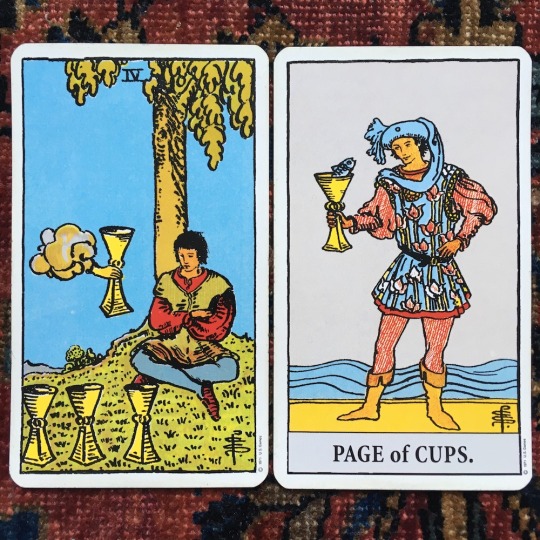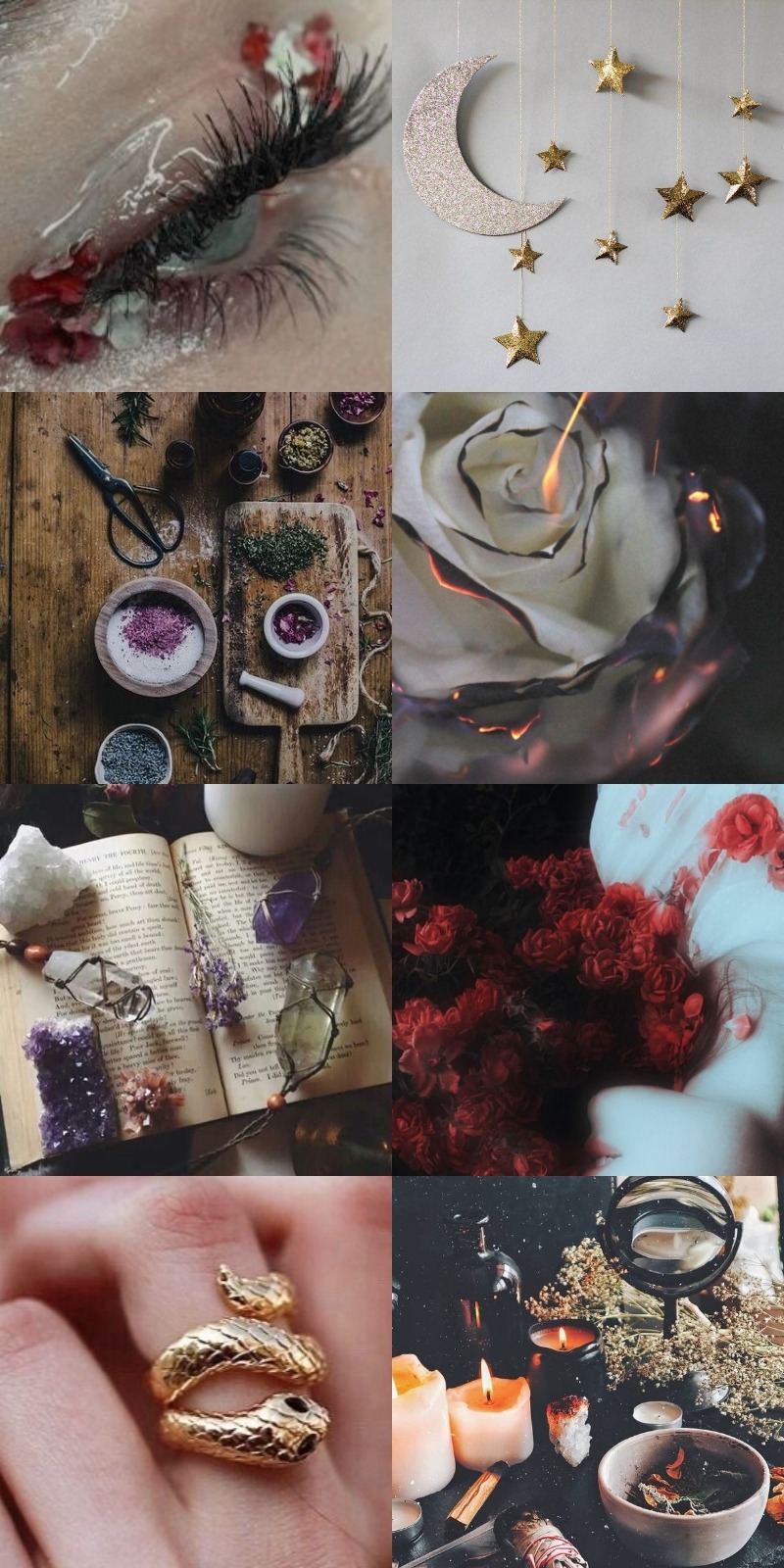Text
Shoplifting as a devotional act to Lord Hermes
49 notes
·
View notes
Text
Sometimes it feels like Astrology Tumblr is dying.
All of my content focused on more sexual/beauty/etc. aspects of Astrology get so much engagement but content that does not focus on that gets very little.
Even when observing other people's posts. It's the same. Love/Sex/Beauty gets all the attention but posts that are not focused on that barely get any.
Don't get me wrong, the sexual and hot parts of Astrology can be fun. That is not all it is though.
I want to talk about deeper things. I value the deeper parts of Astrology. I value talking about aspects, configurations in charts, reading the charts of people in history, all those things.
It just sucks. I feel pressured sometimes to make content I really don't want to but feel I need to.
1K notes
·
View notes
Text
Elements And Their Correspondences
Earth

Direction: North
Time: Midnight
Season: Winter
Color: Green, brown
Zodiac: Taurus, Virgo, Capricorn
Ruling planets: Venus and Saturn
Tarot Cards: Pentacles, Coins
Tools: Pentacle, salt, stones, dirt, crystals, wood, flowers
Cystals: Emerald, Jet, tourmaline, quartz, onyx, azurite, amethyst, jasper, peridot, granite.
Animals: gopher, bear, wolf, ant, horse, stag, deer, dog, cow, bull, bison, snake, worms, moles, voles, grubs
Herbs: Oak, cedar, cypress, honeysuckle, ivy, primrose, sage, grains, patchouli, nuts, magnolia, comfrey, vetivert, moss, lilac, lichen, roots, barley, alfalfa, corn, rice.
Rules: Grounding, strength, healing, success, stability, sturdiness, steadfastness, foundations, empathy, fertility, death, rebirth, wisdom, nature, animals, plants, money, prosperity.
Water

Direction: West
Time: Dusk
Season: Fall
Color: Blue, Indigo, Sliver
Zodiac: Cancer, Scorpio, Pisces
Ruling planets: Moon, Neptune, Pluto
Tarot Cards: Cups
Tools: Ocean, sea glass, cup, bowl, seaweed, hag stones, cauldron
Cystals: Moonstone, pearl, silver, aquamarine, amethyst, blue tourmaline, lapis lazuli, fluorite, coral, blue topaz, beryl, opal, coral
Animals: fish, snake, frog, crab, lobster, eel, shark, dragonfly, seahorse, dolphin, sea otter, seal, whale, alligator, crocodile, beaver, octopus, penguin, salamander, turtle, starfish, koi, coral, barnacle, manta ray, manatee, jellyfish, nautilus, heron, duck, geese, crane, swan, water birds, ammonite, dragons, serpents
Herbs: seaweed, aloe, fern, water lily, lotus, moss, willow, gardenia, apple, catnip, chamomile, cattail, lettuce, kelp, birch, cabbage, coconut, cucumber, comfrey, eucalyptus, gourd, geranium, grape, licorice, lilac, pear, strawberry, tomato
Rules: emotion, intuition, psychic abilities, love, unconscious mind, fertility, self-healing, reflection, lunar energy, deep feelings, curses, death
Fire

Direction: South
Time: Noon
Season: Summer
Color: Red, Orange
Zodiac: Aries, Leo, Sagittarius
Ruling planets: Sun, Mars
Tarot Cards: Wands or Swords (depends on belief system)
Tools: Athame, candles, swords, wands, dagger, lamp, flame
Cystals: Carnelian, red jasper, bloodstone, garnet, ruby, agate, rhodochrosite, gold, pyrite, brass, fire opal, lavastone, tiger's eye
Animals: Lion, snake, coyote, fox, ladybug, bee, shark, scorpion, horse, mantis, tiger
Herbs: Cinnamon, cloves, ginger, allspice, basil, cacti, marigold, chilis, garlic, mustard, nettle, onion, heliotrope, hibiscus, juniper, lime, orange, red pepper, poppies, thistle, coffee, jalapenos, lemon, cumin, saffron, coriander
Rules: Energy, will, destruction, strength, courage, power, passion, lust, sexuality, anger, war, new beginnings, protection, loyalty, transformation, action, movement, achievement, creativity, desire, willpower
Air

Direction: East
Time: Down
Season: Spring
Color: Yellow, gold, white, light blue, pastels
Zodiac: Gemini, Libra, Aquarius
Ruling planets: Mercury, Jupiter, Uranus
Tarot Cards: Wands
Tools: Feather, wand, staff, incense, broom, bell, sword, pen
Cystals: Amber, topaz, citrine, jasper, agate, pumice, alexandrite, amethyst, fluorite, mica, clear quartz
Animals: Birds, flying insects, spiders, bats
Herbs: Bergamot, lavender, marjoram, peppermint, sage, dandelion, bluebell, clover, frankincense, primrose, lemongrass, pine, aspen, yarrow, violets, vervain, myrrh, dill, anise, aspen
Rules: Intelligence, wisdom, knowledge, logic, thought, communication, truth, inspiration, intuition, memory, creativity
Tip jar
234 notes
·
View notes
Text

Week 4 of posting rock thin sections, and what a surprise, more garnet!!!
138 notes
·
View notes
Text
Greek Titans and Primordial gods deserve more love and appreciation in the hellenic polytheism Community!
113 notes
·
View notes
Text
Resourcefulness in the Craft
You can divine by throwing twigs and pebbles onto a graph you made with a sharpie and some printer paper, or use said printer paper to make your own cartomancy deck.
Use cool stuff you find outside as offerings if you want.
My mom taught me how to make wreaths out of porcelain vine or wild grape vines when I was a child, try it. Or teach yourself how to weave a basket.
Use dried "kindling" twigs to make a small besom in the fall.
Find interesting places outdoors, mark them on maps. Create your own correspondences for components you find while out and about.
Raid your own art or office supply storage boxes.
Use twine or tape for binding spells, use staples for curses, fold origami for attracting abundance, use paperclips for memory spells.
And sticky notes for sigils. And felt for poppets.
And a binder with loose leaf notebook paper for your grimoire! Spice it up with dividers for different topics!
Spending money on the tools and ingredients to make a money bowl is incredibly counter-intuitive. Grab stuff from the kitchen like rice, cinnamon, and basil, and stuff from outside like broadleaf plantain, blades of grass, and a cool rock. Scribble some sigils on yellow or green sticky notes, gather some loose change, and toss it all in a bowl you already have with your intention layered between your ingredients and components.
Magical practitioners have always used what was around them. Being resourceful is part of the practice :)
593 notes
·
View notes
Text
Broke Boy Guide to Altar Offerings

Hey! Are you broke but still wanna offer something up to the gods? Don't worry! (So am i) So here's a guide of things that are either free, low cost or that you probably already own to slap onto those altars. Mind you: These are mainly modern offerings that I attribute to these different classification of gods. I'll likely update as time goes on with other classifications :)
General Offerings to Deities:
random flowers from outside
random sticks from outside
hand written letters/prayers
plushies of the animals they're connected to
raw/cooked meats as "sacrifices"
drawn symbols
Art/Creative Deities:
symbol painted bottle caps
pens/pencils/markers
old sketchbooks
stickers/prints
origami
comic books
figurines
Death Deities:
bones or meat from your meals
dirt from a dead plant
dying flowers
skull imagery
coins or other gifts for those passing
photo/belongings of your late loved ones
Familial/Household/Protector of Children Deities:
photobooth photos
jewelry gifted from family
baby teeth from your children
breast milk
old baby shoes
framed photo of family
cookies/bread
homecooked meals
Fire Deities:
birthday candles
charcoal discs
burnt herbs
alcohol
incense
tobacco
matchbox/lighter
Healing Deities:
your current medications
bandaids
water
skincare
vitamin gummies
spell jar in an empty pill bottle
Knowledge/Wisdom Deities:
old books & textbooks
pens/pencils
mini chess pieces
written down philosophical quotes
good test scores/report cards/degrees
Love/Lust Deities:
origami 3D hearts
chapsticks
unused makeup
love letters to deities
love letters about S/O or crush
current perfume/cologne
current lotions
apples
Nature Deities:
plants dedicated to them
herbal tea packets
feathers
milk
fruits/vegetables
spells using recycled materials (toilet paper rolls, etc.)
bread
acorns
Sea Deities:
beach sand
shells
sea water
tiny sea animal figurines
shared fish dinners
makeshift spell jar using a shell
Trickster Deities:
laffy taffy joke wrappers
cards against humanity packs
other comedy card games
982 notes
·
View notes
Text
How to participate in Devotee & Deity Trend
(I invented it but it got enough interest overnight that I’m making an official post to help folks if they want to do this!)
Let’s do this, pagans + witches! I love seeing how devotees resemble their deities’ energies, or even sometimes physical traits.
Post a picture of you alongside your deity! You can post a moodboard, statue, art of the deity, whatever floats your boat, my dude!
Tag the post with #devotee and deity so participating people can find the trend easily!
Don’t you people start judging each other. This is meant to be a fun little online activity to honor our deities! People don’t have to look like their deities to worship them, of course… I just find that a lot of times people give off the same energy as their deity and I think that’s so cool.
Have fun! 😊
95 notes
·
View notes
Text

Have you ever felt so loved by your deities/love your deities so much it makes you wanna be spontaneous? Do something so out of character, out of the ordinary for you because your body is so full of their energy and love?
Sometimes I just sit around and contain the fierce urge to start doing the worm or whatever because of how much energy they give to me.
329 notes
·
View notes
Text
How to Use Tarot to Find Your True God
The old gods are not Barbie dolls on a shelf. No one should pick their deity based on aesthetics or personality quizzes. If you are drawn to paganism, but do not know where you belong, you can use tarot as a guide to find the god who loved you in your past lives.
Step 1: Invoke your higher self.
Find a quiet place where the lights are dim and the air is cool. Take deep breaths until you are calm and focused. Overhand shuffle your cards, while asking your higher self, “Whose mortal child am I?”
Step 2: Draw your cards.
Take the card from the top of the deck and the one at the bottom. If, while shuffling, any cards jumped out and landed face side up, take them too. Otherwise, put any rogues back in the deck.
Step 3: Find your gods.
Gaze at the cards you drew… and wait for your past lives’ memories to come back to you.
Did The Hanged Man play tricks with your eyes and a grew a beard for a split second? You might have seen Odin.
Did the jackal in the Wheel of Fortune give you a vision of the desert? Look to the religion of ancient Egypt.
Did the laurel wreath in the Six of Wands transport you to a windy place with dark blue seas? Follow the footsteps of the ancient Greeks.
Did the Ten of Pentacles seem to rearrange itself into a tree? That symbol is Kabbalistic. Turn to Jewish mysticism.
Did you suddenly think of Spain when you saw the red and yellow in The Magician? Explore the mythology of the ancient Basques. There you will find your gods.
And if the cards somehow led you to the Roman divinities, perhaps you and I share the same gods. Which ones exactly? This will tell you with certainty.
298 notes
·
View notes
Text
The Only Tarot Spreads You Will Ever Need in Your Life
Learn these, and forget everything else.
1. The Celtic Cross Tarot Spread
Gives you a comprehensive answer to any question
2. The Soulmate Conversation
Tells you everything about your soulmate
3. The Three Wishes Tarot Spread
Tells you which of your wishes will come true
4. The Two Paths Tarot Spread
Guides you towards making the right decision
5. The True God Shuffle
Reveals which higher power you are connected to
6. The What If Tarot Spread
Shows you alternate realities
7. The True Colors Tarot Spread
Shows you a person's true colors
8. The General Prediction Shuffle
Tells you about your life in general
9. The Life Purpose Draw
Reveals your life purpose in this incarnation
10. The Major Arcana Grand Tableau
Shows you the full year ahead
11. Your True Passion Tarot Spread
Reveals your true passion and how to live it
12. The Life Advice Shuffle
Gives you advice about life's many departments
13. The Sex Life Draw
Reveals your sex life with a current or future partner
14. The Past Life Tarot Spread
Reveals the truth about your past life
15. Allies & Enemies Tarot Spread
Reveals who your allies and enemies are
16. Your Future Children Shuffle
Tells you about any future children of yours
17. Sports Match Prediction Method
Lets you win meaningful bets
18. Age at Death Prediction Method
Tells you how long you will live
19. The High Priestess Tarot Spread
Answers any question about the future
20. The Time Prediction Method
Reveals the timing of any event
2K notes
·
View notes
Text
Whenever I'm celebrating and drinking with loved ones, I always think of Dionysus. He is the feeling of camaraderie the spreads within our hearts; he is the laughter shared between friends; he is the warmth in sharing a blanket as you watch a movie together. Dionysus is present when friends and family gather, and he comes with the gift of joy, love, and celebration.
Praised be Dionysus! 🥂💜🍇
143 notes
·
View notes
Text

Four of Cups and Page of Cups
You're beginning to be annoyed by the perpetual reminders to hydrate.
383 notes
·
View notes
Text
May Week 1: Diving into Divination
Alright everyone! May has arrived and this month's theme is all about divination! Everything from tarot, to runes to scrying, to other types and forms! We'll try to touch on as many as we can! Without further ado, let's dive in!
Monday - Definitions
Research/ New Page - Let's make a general divination page, and we will make more pages for each individual form of divination as we go! For this page, start with a definition of what divination is, at its base. Look up the history of divination through different cultures. Make a list of the various forms, methods, and types of divination you find. Now, what is divination used for? How has it been used through history and in various cultures? What is your experience, if any, with divination?
Research - Give each form of divination you listed a short description, as the pages we will make later will go much further into detail.
Tuesday - Tarot and Oracle
Research/ New Page - Dive in folks, look up a definition of both Tarot reading and Oracle reading, see how they are similar and different. If you’re familiar with the suits, awesome! If not we will be adding a different suit to study in the coming weeks, along with individual cards. So make a list of all the cards in a tarot and oracle deck, by suit, and we’ll get to descriptions of them all later both upright and reversed. Research traditional uses for these two types of divination, who performed them and where? What kind of questions can they help us answer? What things can they teach and show us? When does tarot reading date back to? Where did it originate? What is and can Tarot and Oracle reading be used for? Gather as much information you can and ask as many questions about the subject you can. The more you find out, the more you know, the better.
Practical/ Journal - If you know how to perform a reading, give yourself a reading. If you are not a reader, see if you can find one. Mind you, this is a service like any other and I support all readers who charge for readings. Do not be afraid to pay for this service, as it takes another person’s time and energy. Journal both the question you asked, and the result of the reading.
Practical - Look up various tarot spreads! Or make one of your own. There are a ton alone here on tumblr. Look into them, how to make them, what they ask, how and why and make one! Feel free to share the spread you make!
Gem study- Again, make a new page or a new note about a specific gemstone. What is it used for in magic? What is it used for in non magical applications? Is it associated with any myths, legends, or deities? Where on earth is it found? What are its other associations?
Wednesday - Runes
Research/ New Page - As with the above, look up and define rune reading. What is it? Where did it originate? Who were the original rune readers? What kinds of questions can we ask during a rune reading? And what kinds of answers and insight can rune readings give us? How do rune readings work? Are they similar to tarot readings? How do you set up a rune reading? What kinds of uses are there for rune readings? Pick a specific rune alphabet, make a list of all of its characters and as we go along this month, or today if you’re feeling feisty, study each rune, its various meanings and how it works within a reading both upright and reversed. Again, find out as much as you can!
Practical/ journal- Either find a reader or with your study into how to perform a reading, give yourself one. Again, I suggest being willing to pay a reader for this, as it is a service that takes time and energy. Journal the question you asked, the rune layout, and the results of your reading.
Herb study - Make a new page or note about an herb you have not studied yet. Look up its origins, how to grow it, its culinary, mundane and magical uses, along with its various associations. How was this herb used and thought of throughout history? Does it have any relation to myths and legends?
Thursday - Scrying
Research/ New Page - Define scrying! What is it? How does it work? What are some common methods of scrying? Where has scrying been used traditionally? Who were the first to scry? How does one perform a scrying? What kinds of information can we glean from scrying? What things can it show and teach us? What is scrying generally used for? Find out as much as you can about scrying!
Practical/ Journal - Perform one of the simpler methods of scrying that you researched, then journal about the experience! What did you see? Hear? Feel? What did it show you?
DiY - There are plenty of resources on the internet for making scrying and divination tools in general! This prompt is to create a scrying mirror! It does not have to be one of the fancier ones. But make one! There are even instructions here on tumblr, I’m sure!
Friday - Pendulum
Research/ New Page - Now we’re going to look into Pendulum readings! (and pendulum work in general!) What are the ways we can use pendulums for divination? What kinds of things can pendulums help us divine? Where and when did pendulum reading originate? What can it show us and teach us? What is pendulum reading traditionally used for? Look up different methods of using pendulums.
Practical/ Journal - Make a pendulum! You don’t need a fancy one in order to perform divination with them. Look up a way to make a pendulum with everyday objects and perform a pendulum divination! Journal the process from the making of the pendulum to reading and its results.
Meditation/ Introspection - We’ve given ourselves a lot of insight this week, asked a lot of questions of the universe and hopefully found some insight and answers into the /whys/ behind all these questions. Take some time to think about the answers you’ve gotten. Journal about all of the results and the way they apply to your life and current situation.
WHEW! That was a lot, huh? So much to discover! Let's take the weekend and rest, since we got so much work done this week!
Good luck and happy crafting witches!
-Mod Hazel
47 notes
·
View notes
Text
Ambient Spells
The idea of the ambient spell isn’t so uncommon. My use of the word “ambient” may throw you for a bit of a loop. An ambient spell is any spell that permeates a space in an unobtrusive way. They affect the area surrounding their vessel and require little to no maintenance or upkeep. They’re long-term workings that require varying levels of effort to put together and cast. Depending on what exactly you need, they can be as simple as setting out a bowl of salt or as complex as crafting a home decor piece from scratch.
I always recommend making ambient spells that are self-fueling. I often refer to them also as “set it and forget it” spells. They’re the crockpot of spellwork — work up front for a slow burn output.
Chances are that you’re already aware of or even know how to create ambient spells. Any spell that affects the vibe of a room, for example, would count as an ambient spell. Lighting incense specifically to invite in positive energy counts. A ward that sucks up baneful magic and transforms it into blessings also counts. The primary idea of an ambient spell is that it’s making a change to your environment in the background. It’s the cool breeze in summertime, the subtle piano at a fancy restaurant, the scent of fresh-baked cookies fading as the day goes by. Positive, but not overt.
When to Use (or Not Use) an Ambient Spell
By their nature, ambient spells are fairly general workings. They can be quite powerful, of course, just like any other spell. The thing to keep in mind is that they’re not ideal for targeted magic.
For example, I wouldn’t create an ambient spell to banish someone from my life. I might make an ambient spell to make an area unwelcoming to them, or to anyone who would do me harm. The unwelcoming vibe might discourage them from coming around, sure. But it may not work outside of the area the spell lives in; and it may not get rid of them for good.
Similarly, an ambient spell might make a good general ward for keeping out loud, unwelcome spirits, but it wouldn’t specifically cast out the one particular spirit who’s been causing problems. It might discourage their behavior, but it wouldn’t necessarily get rid of them. A concentrated, single-use banishing spell would work significantly better for that purpose. Afterwards, an ambient spell can keep the area clear of that spirit’s influence.
I also wouldn’t use an ambient spell to draw in specific success. General success or money, absolutely — whatever wants to come my way is welcome, via a basic money bowl set up next to my wallet. But if I specifically want a promotion or a particular amount of money, I’m not going to leave that to the ambient money spell. I would craft a spell specifically for what I’m looking for.
When deciding what kind of spell to cast, keep this idea in mind. An ambient spell is best for behind-the-scenes results that happen without your concentrated effort. When you want something specific, a more targeted spell will work better nine times out of ten.
Creating an Ambient Spell
It’s possible to create an ambient spell with nothing but energy work. However, I often find that these fade quickly and don’t lend themselves well to self-fueling. They tend to need more active upkeep than I prefer for a spell that’s meant to be set and let go. I recommend choosing an appropriate vessel of some kind to contain the spell to help it last longer.
How do you decide what’s an appropriate vessel, though? And how do you set one up? How do you make a spell self-fueling? Let’s start from the top and go in order.
Identify the Purpose
Decide what the spell will do. This is going to define the components and the way you’re going to cast the spell.
In my experience, ambient spells work best when they’re given a single purpose. For example, I wouldn’t make a spell that’s a ward and a cleanser and a spirit welcome mat. It dilutes the purpose. Choose a single, clear motive for the spell.
Choose a Vessel
Now that you know what your spell will do, it’s time to decide what it’s going to look like. The vessel you choose should reflect the spell’s purpose in some way.
An open bowl works well for absorbing energy. Why? It’s open. The face of it is open to the room, ready to take in whatever kind of energy you assign to its contents.
A closed jar, on the other hand, would be good for repelling. It’s closed off and sealed — a one-way road going out of the jar and into the room to clear it.
A wreath hung at the door could serve a lot of purposes, depending on what it’s made with. I would use a wreath as an agent of transformation or as an energy emitter to release a certain energy into the space.
A stone makes a solid vessel for protection or grounding. I have one on my working altar to help keep me in the moment and create a good environment for working magic.
When you’re choosing your spell vessel, keep in mind how visible you want it to be. Certain vessels are going to naturally be more obvious than others. A wreath, for example, is hard to miss — but it also just looks like nice home decor. A jar full of herbs and things would be more obviously a spell, but they can be small and easily hidden.
I have both obvious and hidden ambient spells peppered around my home for varying purposes. If you’re keeping your practice a secret, you’ll likely want to keep your spells more obscure or hidden. But if you aren’t, and you can make the choice of whether you want the spell to be in plain sight or not, consider the effect you want the spell to have.
If you want the spell to absorb bad vibes, baneful magics, the evil eye, or other negativity, a hidden spell might serve you well. Hiding the vessel somewhere means that whoever’s casting against you may not expect the resistance. On the other hand, if you want a vessel that allows friendly spirits to visit you during the holidays, a beautiful centerpiece on your dining table that’s charmed with spirit-friendly magic might serve the purpose.
Choose an Energy Source
Ambient spells need to draw energy from somewhere. Think of it like a battery. The ingredients you put into the spell may provide a temporary charge, but if you want the spell to be long-term, it needs an input. How will your spell recharge itself?
If you want the spell to be shorter-term, only a few days or so, then you can skip this step. But if you want an ambient spell to last a while, like a ward or vibe-adjuster, you’ll need to think about this carefully.
Like when choosing the vessel, the energy source should match the purpose of the spell. For example, I have a simple room refresher spell set on a table that’s central to my home. The purpose of it is to take anxiety and negative thoughts to turn them into positivity. I set it up so that the act of walking past the bowl swirls the air around it, and therefore also the energy around it. That kinetic energy fuels the bowl’s magic and keeps it going. I don’t have to actively recharge the bowl or its contents, because we walk past it constantly.
Another example would be an ambient spell to help you do the dishes. (Whether that’s remembering to do them or finding the motivation for it is up to you.) The fuel for the spell could be the act of walking into or past the kitchen, running water elsewhere in the home, or even cooking or eating.
The energy source could also be something like lighting a candle next to or over the vessel on a schedule, if you prefer. This would add an upkeep step, of course, and wouldn’t be my first choice. The only ambient spell I do this with is my money bowl, and that’s because it’s tuned to be able to shift focus from day to day depending on what exactly I need (commissions versus tips versus discounts, etc.).
Setting Up an Ambient Spell
Decide where you want to place your spell’s vessel ahead of time. If you have pets or kids, make sure you put whatever it is out of their reach. If the vessel is something like an uncovered bowl, you’ll want to be sure that it isn’t going to get knocked over. Similarly, if it’s made of glass, you don’t want it to fall and shatter. If your vessel needs to be hidden somehow, determine where you’ll keep it. It would be smart to make note of where the spell is and what it looks like in your grimoire or spell notebook just so that if you forget about it, you can identify it later on down the road.
After you know where you want to put it, it’s time to choose ingredients and fill your vessel. The components you decide on should, obviously, match your goals.
Casting an ambient spell is much the same as casting a regular spell. The only thing to keep in mind is that an ambient spell has a sort of prolonged release.
Upkeep and Care of an Ambient Spell
For the most part, ambient spells should require little to no upkeep. With that said, you should still do routine check-ups on them. I include them in my regular rounds when I check on my wards and various protections, but you could do yours whenever it makes the most sense to you.
Depending on how you decided to fuel your spell, you may need to do a bit of feeding. Whether that’s lighting a new candle, refilling a cup of water, mixing around a pile of herbs, or giving the vessel a little shake, do so anytime it feels like the spell’s energy is flagging. It may take some practice in sensing energy to know exactly when a spell needs refueling. This is partly why I suggest creating a schedule to check in on the spell; ambient spells are a great type to practice sensing spell energy, since they’re typically long-lasting and may wax or wane depending on the day.
If your spell is fully self-fueling and it doesn’t seem to be working anymore (or at all, even from the start), it’s time to take it apart. Discard disposable components according to your practice’s tenets. Cleanse the rest for future use. I would suggest washing your spell vessel alongside magical cleansing.
A Ready-to-Use Example
Here’s an extremely simple example of an ambient spell I use in my home to keep the main living area light, fresh, and conducive to getting work done. Since both my partner and I work from home, it’s important that our areas have an aura of focus.
Materials:
- A small bowl, preferably green or brown
- Enough salt to fill the bowl halfway
- A few pinches of dried rosemary
Instructions:
1. Ensure the bowl is clean and dry. Pour salt into the bowl until it’s halfway full.
2. Sprinkle dried rosemary into the salt and stir.
3. Instruct the spell, in whatever way makes sense to you, to exude focused but calm energy into the space.
4. Place the bowl in an area that is frequently trafficked.
5. Leave the bowl in place until it no longer provides a fresh, focused energy to the space. Dispose of the contents, clean the bowl, and reset the spell.
Notes:
- This spell is powered by movement specifically, because both my partner and I work from home, and we pace when we’re having a hard time focusing. The spell draws in the energy from our pacing and the frustration we’re putting out to fuel itself. It then transforms and releases the energy as calm, focus, and productivity.
- I suggest a green or brown bowl because this spell is meant to work for our jobs. Green for success, brown for grounding. Personally, my bowl has both colors.
- When instructing the spell, you can speak to the bowl, write a petition, do an incantation, or whatever else you like. This is the most personal part of the spell, and it’s what makes the thing Go. It’s up to you to decide how it’s going to work.
Final Thoughts
I would hesitate to call ambient spells “low energy” spellwork. While they can be low-energy-friendly in the long run, and they can be extremely simple to set up (such as the one I described above), they aren’t always. Ambient spells do require an up-front energy cost. Even so, I find them very rewarding and useful.
Folks who visit my home often comment that it’s an inviting, friendly, good-natured space where they can leave their worries and anxieties behind. That’s on purpose. I’ve got ambient spells in place that eat up anxiety and spit out positivity. I’ve got ones that repel hexes and are charged by sunlight. All of these spells are long-lasting and well worth the effort it took to create them.
I hope this little guide is useful to you! If you’ve got questions, feel free to send me an ask. I’m happy to ramble about ambient spells or other types of magic as much as you’d like.
And if you did enjoy this post, consider dropping a couple dollars in my tip jar! Supporters of all types (tips, commissions, shop purchases, and memberships) get early access to posts like this, sometimes up to two weeks early, and every bit helps me keep the lights on.
601 notes
·
View notes
Text
Resourcefulness in the Craft
You can divine by throwing twigs and pebbles onto a graph you made with a sharpie and some printer paper, or use said printer paper to make your own cartomancy deck.
Use cool stuff you find outside as offerings if you want.
My mom taught me how to make wreaths out of porcelain vine or wild grape vines when I was a child, try it. Or teach yourself how to weave a basket.
Use dried "kindling" twigs to make a small besom in the fall.
Find interesting places outdoors, mark them on maps. Create your own correspondences for components you find while out and about.
Raid your own art or office supply storage boxes.
Use twine or tape for binding spells, use staples for curses, fold origami for attracting abundance, use paperclips for memory spells.
And sticky notes for sigils. And felt for poppets.
And a binder with loose leaf notebook paper for your grimoire! Spice it up with dividers for different topics!
Spending money on the tools and ingredients to make a money bowl is incredibly counter-intuitive. Grab stuff from the kitchen like rice, cinnamon, and basil, and stuff from outside like broadleaf plantain, blades of grass, and a cool rock. Scribble some sigils on yellow or green sticky notes, gather some loose change, and toss it all in a bowl you already have with your intention layered between your ingredients and components.
Magical practitioners have always used what was around them. Being resourceful is part of the practice :)
593 notes
·
View notes
